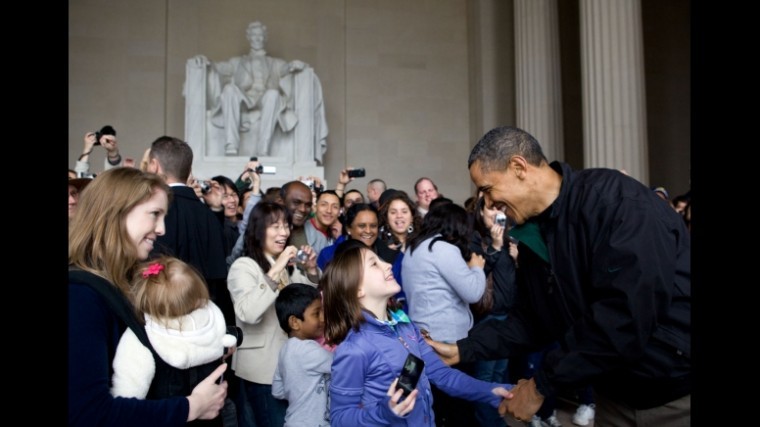WASHINGTON – With a little more than an hour to go before their midnight deadline, President Barack Obama, Democrats and the GOP reached a compromise Friday night that brought the wheels of a government shutdown to a screeching halt.
A shutdown would have effected 800,000 federal employees and had a major impact on tourism.
Even though the House and Senate passed temporary resolutions to keep the government funded beyond midnight, on April 8, the full agreement has yet to be drafted and passed by Congress.
President Obama is slated to speak about deficit reduction and a broad plan to scale back on costly entitlement programs today, April 13, at George Washington University.
According to CBS News, after an agreement was reached by both sides around 11 p.m. Friday night, Republican House Speaker John Boehner and Democratic Senate Majority Leader Harry Reid said in a statement: “We have agreed to an historic amount of cuts for the remainder of this fiscal year, as well as a short-term bridge that will give us time to avoid a shutdown while we get that agreement through both houses and to the President.”
“We will cut $78.5 billion below the President’s 2011 budget proposal, and we have reached an agreement on the policy riders,” they said. “In the meantime, we will pass a short-term resolution to keep the government running through Thursday. That short-term bridge will cut the first $2 billion of the total savings.”
If lawmakers had not made a deal, the government would have seen its first shutdown since the Clinton Administration 15 years ago.
In 1995 and 1996, the federal government shutdown was the result of an ongoing conflict between Democratic President Bill Clinton and the GOP over funding for Medicare, education, the environment and public health.
Government workers were given a five day furlough from Nov. 14 through Nov. 19, 1995, and about three weeks from Dec. 16, 1995 to Jan. 6, 1996. The major players in the showdown were President Clinton and the Speaker of the U.S. House of Representatives Newt Gingrich.
Despite a sharp decline in poll numbers, Clinton still emerged the winner of that epoch battle.
This time, however, the threat of a shutdown had much to do with whether or not the government would continue to fund Planned Parenthood, which Republicans were very vocal about not doing.
President Obama and his supporters were able to stop Republican efforts to defund Planned Parenthood and international family planning programs as well as his historic Affordable Care Act. The GOP also wanted to limit funding for the establishment of the new Consumer Financial Protection Bureau and block the Environmental Protection Agency (EPA)from enforcing clean air and water rules
In The White House Blog, President Obama said: “The two sides agreed to cut $13 billion from funding for programs at the Departments of Labor, Education, and Health and Human Services as well as over $1 billion in a cut across non-defense agencies, forcing everyone to tighten their belt. There will be reductions to housing assistance programs and some health care programs along with $8 billion in cuts to our budget for State and Foreign Operations,” he said.
The president also added that they were able to avoid “terminating 60,000 children from the Head Start Program in September and to provide adequate services to student loan borrowers.”
“We protected funding for critical programs that invest in science programs, our kids’ education, and critical health programs,” the President said in The White House Blog. “We are maintaining current levels of Head Start enrollment, funding Race to the Top, including an early learning element, and have sufficient savings available to maintain the Pell Grant maximum award and the broad education reform agenda, including K-12 education.”
He added: “There is still robust investment to efficiently and effectively run Medicare and to implement the Affordable Care Act.”
The president said one of their goals was to go after wasteful spending and earmarked, special interest programs including $630 million in earmarked transportation projects and at least $2.5 billion in transportation funding that is ready to be earmarked.
They were also able to cut $35 million by ending the Crop Insurance Good Performance Rebate, which gives successful farmers, who have no claims, a rebate for insurance premiums already subsidized by the federal government.
In addition to these cuts, they eliminated $30 million for a job training program that was narrowly targeted at certain student loan processors.
They also looked to the Defense department for savings, and were able to identify $18 billion in cuts deemed unnecessary by the Pentagon.
“These types of cuts are what the American people expect out of their leaders in Washington,” the President said.
In the end, President Obama praised the efforts of the Democrats and Republicans that came together for the “good of the people,” but he readily admitted there was more work to be done on all sides.
“We all know that we face tough challenges ahead, from job creating and growing our economy, to educating our children and reducing our deficit, and we must continue to work together to achieve those goals and deliver for the American people,” he said. “Just as families across the nation do everyday, we had to make tough choices and begin to live within our means, but we also had clear lines that protected the investments we need to win the future.”


Be the first to comment